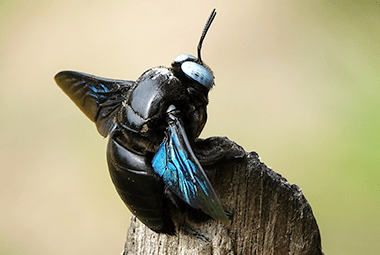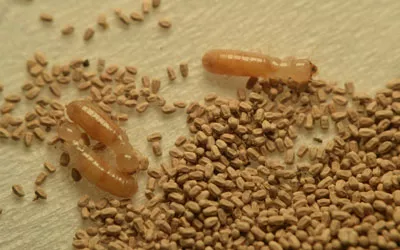Just like other species of insects and animals, carpenter bees become active again once the majority of the winter season is over, the weather begins to warm slightly, and the spring season is just around the corner. In Knoxville TN, this is usually anywhere between mid-February and April. Carpenter bees aren’t just a nuisance, as they can cause a lot of problems with their wood-boring habits. The team at Russell’s Pest Control is committed to keeping you safe from the dangers of pests year-round, carpenter bees included. Keep reading to learn all you need to know about carpenter bees near your Tennessee property.
Dangers of Carpenter Bees in Knoxville TN
When it comes to carpenter bees, they tend to be more damaging to property than they are a danger to people. Here’s what to know:
- Only the female has the ability to sting, but the females are typically pretty docile and they rarely sting on purpose. It is still important to remember that if you are ever stung by a carpenter bee, you should take the same precautions as you would with any other bee sting, especially if you are allergic to their venom.
- Even though these stinging insects are not particularly dangerous, they are very damaging. In fact, the damages that carpenter bees can cause can become quite extensive and expensive to repair if they are allowed to continue nesting on your property.
- Carpenter bees create perfectly round holes that are about ¼ of an inch in diameter; once inside the wood they make a turn a create tunnels along the grain of the wood to lay their eggs in. Carpenter bees are solitary, but it is very typical for several females to choose the same area or even the same piece of wood to nest inside of. Over time, this damage can worsen.
Signs of Carpenter Bee Activity
If carpenter bees have decided to take up residence on your property, you will notice large bumblebee-like insects that are black in color flying around your property under or around wooden structures. If carpenter bees are nesting on your property you will probably also begin to notice dime-sized holes in wooden outdoor furniture, eaves, wooden trim, wood shingles, and wooden play structures. Another seemingly strange sign of a carpenter bee infestation on your Knoxville property is noticing an increase of woodpeckers. Woodpeckers love to dine on the larvae and eggs of carpenter bees, they are attracted to the nest from the sounds that the larvae make and will peck at the nest entrance hole in order to enlarge it and gain access to bees inside. Needless to say, this causes even more damages to the structure that is housing the carpenter bee nest.
How to Prevent Carpenter Bee Problems
Preventing carpenter bees from choosing your property to invade can be a difficult task, but there are a couple of easy ways that you can deter them from choosing your Knoxville home or property to nest on.
- First, inspect the exterior of your home and any wood wooden structures located on your property. Any holes found should be filled in with a quality wood filler. Holes found in wooden structures have the potential to attract adult carpenter bees that are looking for a place to nest.
- Varnish, stain or paint any wooden structures on your property to help prevent them from becoming water damaged. Carpenter bees are highly attracted to water-damaged wood.
Need Help With Carpenter Bees?
Since it is almost that time of year again when carpenter bees are going to once again become active, now is the time to safeguard your property. When you work with Russell’s, our bee control experts will come to your property, identify any problem areas, and put into place a plan of action to protect your home and property from being further damaged by these rogue carpenters. Contact us today to learn more!

